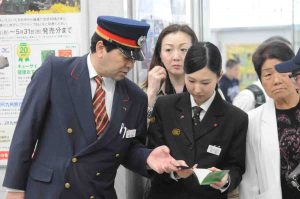How to improve
Below are some pieces of advice for learning Japanese in earnest:
Beginner
- Learn to read and write the basic 46 hiragana – set yourself a target of learning at least two a day. This knowledge will help you retain what you learn, pronounce better and have a firm grip on the structure of the language.
- Learn and practise reading katakana-noun-words such as supootsu(スポーツ、sport),doa (ドア、door) or paatii(パーティー、party), and make sure that you can write your name in katakana.
- Make your own vocabulary cards on which there are no English definitions. Instead, draw some simple pictures or cite good examples from target textbooks to illustrate the meaning.

- Enhance your Japan-awareness by going to Japanese films, listening to Japanese music and eating Japanese food.
- Learn some useful phrases such as Ohayoogozaimasu(おはようございます), Itadakimasu(いただきます。), Jyamata(じゃ、また。).
- Plan to go to Japan for at least two weeks in the near future.
[show_more more]
Intermediate
- Learn only the most relevant reading of a kanji. You don’t have to know all the readings. Which reading to know depends on your level
One of the best ways to learn the appropriate reading is to learn these in the right context for your level. For example, the kanji byo(びょう、病) as in byooin (病院、hospital) has another reading, yamai(やまい), but this reading may not be of any use until you reach a more advanced level. - Make sure that you can construct complex sentences with so-called adjective clauses. For example, Yamada san ga kinoo yonda hon wa watashi ga 1-chinen mae ni yonda hon desu.(山田さんが きのう 読んだ本は わたしが 一年前に 読んだ本です。) (The book that Mr Yamada read yesterday was the book that I had read a year ago.)
- Distinguish intransitive verbs from transitive verbs that have a similar meaning. For example, otosu(落とす) means ‘to drop’ as in You dropped a pen on the floor., but ochiru(落ちる) means ‘to drop’ as in Your pen dropped on to the floor a few minutes ago.
[/show_more]
[show_more more]
Advanced
- Get rid of bad linguistic habits that you are likely to have developed over the years. The incorrect use of particles can be one of these.
- Read a lot of Japanese books to learn how we express ourselves, as this is distinctively different from the way European people express themselves.
- Chat about anything with any Japanese people as often as possible to learn the informal/formal register.
- Buy a good Japanese-Japanese dictionary, which is publised for Japanese children, so that you can refer to this instead of a Japanese-English dictionary.
- When you talk to Japanese people, be attentive to their use of vocabulary/phrases/expressions. Make a note of those you have never heard of. Afterwards, check them and if they turn out to be useful/interesting, add them to your list and try to use them in the right context.
- Be consistent in the degree of politeness.

If you talk to your Japanese friends, always use friendly (informal) forms. However, when you talk/write to your Japanese teacher, always communicate in politer terms. Employ proper nouns/adjective/pronouns/verbs, etc. You have to be consistent in terms of politeness; do not mix less polite forms with politer forms as this makes it seem you don’t really know advanced Japanese grammar. - Realize that Keigo can be classified into at least three categories – sonkei (respect), kenjyo (humble), teinei (polite).
[/show_more]
